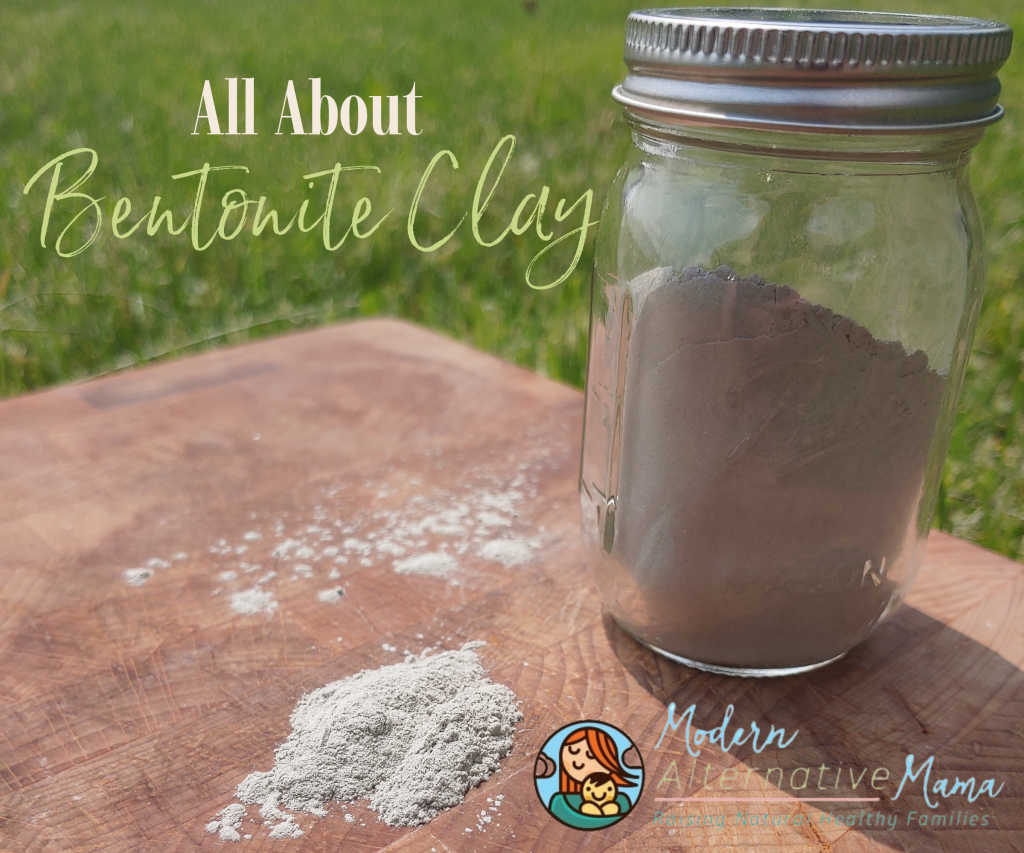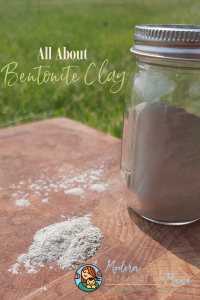By lead writer Kate Tietje, with Kresha Faber and Rustina, contributing writers
I don’t know about you, but we’re always looking to improve our natural medicine kits. I don’t use any form of OTC or “mainstream” medicine at all (especially not for acute illnesses). With so many different options out there, and many of them expensive, it’s hard to know what to include in your medicine cabinet. It’s important to have all the basics covered, but sometimes space is limited.
I’m becoming more choosy about what I really keep around. I keep things that I really, actually use, that have been proven to help my family in a variety of situations. Bentonite clay is one of those very useful tools!
What is Bentonite Clay?
This is a mineral swelling clay that carries a negative electrical charge. Most toxins and junk in your body are positively charged. When the toxins are exposed to the clay, it binds with the toxins and pulls them safely out of your body.
Fun Fact: it can absorb up to 10-20 times its weight (1)!
Pretty neat, no?
Clay is generally very safe to use, non-toxic, and I haven’t yet heard of anyone being allergic to it. Many are concerned about lead content in bentonite clay. Since that would take up a lot of conversation, we address that here in: Is There Lead In Bentonite Clay?
Some Great Benefits of Bentonite Clay
Detoxing and Heavy Metal Chelation
Clay works wonderfully for this because the small electrically charged particles act both as a sponge and a magnet, pulling heavy metal and other toxic particles to themselves and holding on to them as it dries, pulling it out of the body. Of course, some good nutrients may also bind to it as well. It also contains trace amounts of many of those good nutrients so as long as it is used externally or only for short term internally, the nutrient absorption should be minimal.
See Kate’s detox method for how she uses clay, even as an exclusively-breastfeeding mama.
Read how to take a detox bath.
Drying Agent
Clay is also excellent to heal skin, especially sensitive skin, like a baby’s bottom. When clay is dry, it is hydrophilic – water-loving. Therefore, it draws moisture to itself. In the case of a baby’s bum, this gives wonderful relief for an already-existent rash or helps prevent rashes in the first place. This is especially helpful on babies that have adorable rolls of baby fat and lots of folds where moisture can get trapped.
Clay can be used as a baby powder just by sprinkling a bit of clay onto the bum or can be mixed into a homemade diaper cream to provide drying action in addition to a moisture barrier.
It is used in hair masks to help balance oil production as well (2).
Anti-inflammatory and Relieves Itch (bug bites, stings, and skin rashes)
Summertime = bug bites. And bug bites are itchy. My 3-year-old was stung and came into the house complaining his arm was red. I could use the small hole indicating a sting and I knew there were wasps in the backyard. I administered a homeopathic remedy (apis) and put clay over the sting. Within an hour, there was no more mark and he said it didn’t hurt anymore.
Clay both soothes and draws out impurities. You can mix it with activated charcoal and make a drawing salve that works nicely. No time for DIY? Buy some at our store: Earthley’s Black Drawing Salve
Find more remedies here: Natural Remedies for Bug Bites and Stings
It is great for contact dermatitis from things like stinging nettles, chicken pox and eczema.
Just like for detoxing or chelating, baths are a great way to use the power of bentonite clay to draw out toxins. For dealing with itches though add oatmeal or baking soda to the clay bath. The difference between just a plain oatmeal or baking soda bath is that the clay will actually draw out any substances that are causing the itch in addition to providing a soothing feeling. Just be careful to not add too much clay or you can trigger a systemic detox, which can lead to headaches, irritability, and other unwanted side effects, especially in children. About 1/4 – 1/2 cup of clay in a warm bath should be just about right.
My husband also used the clay on some small yeast-related bumps on his arms and some poison ivy. The clay helped to draw these out and soothe it away.
Clean Teeth
Clay gently polishes teeth and is an effective, mineral-rich, alkaline dental cleanser. It’s also a great fluoride-free toothpaste, whether you purchase a commercial clay toothpaste or make your own. It’s also an important ingredient in remineralizing tooth powder.
I especially like using clay toothpaste with my young children who are just learning to brush their teeth, as I don’t have to worry about them swallowing the toothpaste. If they swallow clay toothpaste, it’s actually beneficial – they just need to drink a good amount of water to help it flush out.
Relieve Burns
Clay soothes minor burns which for children can be especially welcome. In this case, there aren’t toxins to draw out, per se, so keep the clay wet to maximize the soothing effect. Merely smear a thick layer of well hydrated clay over the burn and wrap it with plastic wrap, gauze, or cheesecloth to keep it from drying out.
I use the Black Drawing Salve for this also.
Relieve Diarrhea and Sore Tummies
Clay can restore balance for an upset stomach. It can help diarrhea, ease tummy aches, or as a digestive aid (stomach issues, such as ulcers, nausea, and acid reflux). I would take it internally for a short time such as a stomach bug, but I wouldn’t do it everyday. Be sure to drink lots of water to keep it all moving along.
Dr. Weston A. Price, in his book “Nutrition and Physical Degeneration” reported that several native cultures, including those in the Andes, Central Africa, and Australia, consumed clays in various ways, most often carrying balls of dried clay with them as they traveled and dissolving a small amount of the clay in water with meals to prevent poisoning from any toxins present.
And just to illustrate clay’s historical uses when dealing with stomach bugs and infectious disease, there is even anecdotal evidence that clay was used to treat cholera and the Plague.
Helps Wounds
Every mama wants to have something quick and easy to apply to the cuts and scrapes that inevitably come with a child who is living life to the fullest (that is, who is outside exploring, discovering, and playing to the max). A well-stocked natural first aid kit is a blessing!
Applying a thick smear of hydrated clay over cuts and scrapes will help fight infection (3). Just keep it covered, both to protect the wound and to keep it from drying out.
Bentonite clay can also help slow bleeding (4).
And due to clay’s ability to draw toxins out, it’s also an excellent home remedy for mastitis, where the breast milk needs to be drawn out of the inflamed area. Merely mix clay and water to create a thick poultice and apply as needed every 1-2 hours until the infection is gone. In this case, you want to let the clay dry, as that is what creates the “pulling” action.
Softens and Smooths Skin
We mamas are often well aware of how our bodies show the proud signs of age, childbearing, and breastfeeding, so anything we can do to “feel pretty” is much treasured. Here are a few ways I like to use clay in this regard:
Using a clay facial mask will soften skin, draw out impurities (like blackheads), and smooth wrinkles.
Clay can smooth skin and reduce itching after shaving. Just rub dry clay over the shaved area.
Clay detoxifies the scalp for lustrous hair. Just mix clay and water into a thick paste and rub vigorously into the scalp. Let sit for 5-10 minutes, then rinse well. Repeat at least once a week.
And you can even use it in homemade make-up!
Using clay as a facial mask can help draw the gunk out of your pores, clearing up your skin (this is probably the best-known use for clay). Another popular use is in a bath, to pull the toxins out through your skin. We have done this, and it helps, but it is very messy!
When added to sun lotions, it was shown to block a lot of the UV light – one of the best performing materials tested in this study.
How to Use Clay
As you can see, there are a lot of excellent uses for clay! It’s very safe to use, even for younger babies (externally). It has a multitude of properties, meaning this one item can help with many common ailments — freeing up both space in your medicine cabinet and money!
The best idea is to get clay in at least two preparations, and possibly three. These would be:
- Loose Powder – as a drying agent or in a bath
- Paste – to be used immediately on external issues, also travels well (Black Drawing Salve)
For a simple drawing paste/mask, use a 1 part clay to 1 part water/apple cider vinegar ratio.
For a thicker paste, use 2 parts clay to 1 part liquid.
Recipes to try:
DIY Detoxifying Deodorant Cream
What’s your favorite way to use bentonite clay?



